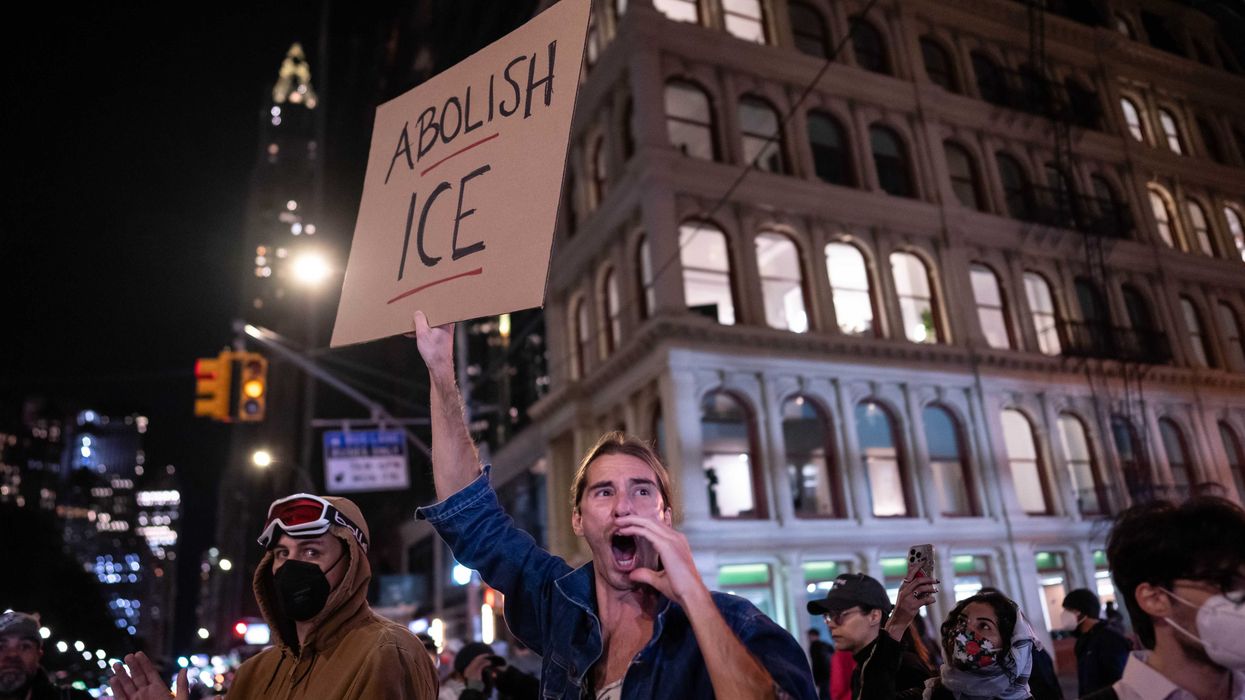Michelle Malkin teamed up with Glenn and Mercury Ink for a new book: ‘Who Built That: Awe-Inspiring Stories of American Tinkerpreneurs’. She joined Glenn on the radio show Monday to talk about some of her favorite stories from the book and what she learned while putting it together.
Below is a transcript of this interview:
GLENN: So today, we're not just going to whine about it. We actually have a solution. And it actually started with a charity. Back in 2010, this program asked Michelle Malkin if she would donate something to -- what was it, for the Restoring Honor event, I think it was. She said, yes, I'll do a charity fundraiser and I'll take people on a train ride in Colorado. And we mocked it. We were like, oh, that's good. Michelle all by herself with strangers on a train.
PAT: A hike or something.
GLENN: Come into the woods with me. It was not a good idea. But it was that that gave birth to what we're about to announce, and she's about to release tomorrow. Michelle Malkin is here with us now. Hello, Michelle.
MICHELLE: Hi, Glenn.
GLENN: How are you?
MICHELLE: Good. How are you doing?
GLENN: It's been a very long journey for this.
MICHELLE: Yes. It's been like a train ride up Pikes Peak.
GLENN: You took a train ride up to Pikes Peak. Then I think a year later or two years later, we were doing the big deal that weekend at Dallas Cowboys Stadium for Restoring Love, and you had come in for a Freedom Works event at the American Airlines Arena. And you and I spent some time backstage, and we started talking about entrepreneurs and people who did build that.
MICHELLE: Yeah, we totally geeked out. And I think we discussed everything from, you know, the tinkering penchant to the teaching of math in this country and, of course, a lot of that was the groundwork for the work that we've done together on Common Core. And I think that this book is absolutely an extension of those conversations and, you know, you've had a pivotal role in all of this. And it kind of underscores one of the themes of the book, which is the magic and the miracle of the voluntary exchanges of ideas and goods and services that happened in this country every single day without the hand of government. Without a federal department of innovation or an innovation czar or somebody telling us what we should invest our money in. And, you know, whether it's something as mundane as a book or a bottle cap or a roll of toilet paper, these things happen not because somebody decides in Washington that they're going to happen, but because people want them and need them. And we have a free market system that has served us extremely well. So for the president who keyed up the launch of this book perfectly with his remarks last week that you just highlighted, thanks Obama. For him to have such scorn and open contempt for this country, I couldn't stand it anymore. And that's what drove this book. Of course -- of course, in a capitalist system, we want to make money. Everybody who is an inventor or builder wants to make money. But do you think that's the ultimate driver? That's the engine? No. It's this insatiable need and drive to make something in the world and fix it and tinker with it all your entire life. And so, you know, I have these tinkerpreneurs in the book who, yeah, they came up with one thing and then another. And they had hundreds and hundreds of patents. And they worked themselves until they couldn't work anymore. And you certainly can't say that of the golfer-in-chief on 1600 Pennsylvania Avenue.
GLENN: Okay. So now the name of the book is Who Built That. And you cover everybody. I want to cover a couple of chapters. I want to start with something that I didn't expect to find in the book, which I found strangely fascinating. I, Toilet Paper.
[laughter]
MICHELLE: Yes. Well, you know, I talked about how -- I think that we take for granted especially in the 21st century internet age, the mundane things that we absolutely need. And I picked toilet paper for a number of reasons. When you look at a place like Venezuela, and I think the shortage of toilet paper there is so ultimately symbolic because they can't even make that. What does that say about the absence of a free market, the absence of choice, the absence of the ability to profit off of things? And toilet paper is one of those products that encompasses hundreds and hundreds of different kinds of entrepreneurs. And so I trace the history of toilet paperback to the Founding Fathers, and if you love history, if you love tinkering, you're going to love the book, because you're going to learn so many things about how the voluntary cooperation of even some of the Founding Fathers play into the chapter as well. I wrote in the voice of a roll of toilet paper because I was inspired by one of my favorite all-time essays that is such a great learning tool, especially for elementary school kids. Was written by Leonard Read, who was a Libertarian economist who wrote the very, very famous essay I, Pencil to illustrate this example of how the concentric circles of individuals pursuing their own self-interests produced something like a pencil, something that no government bureaucrat could ever order with an executive order.
GLENN: Right. I have to tell you. I'd hate to harp on the toilet paper part, but I was shocked what I learned about toilet paper. I was shocked that, you know, Poor Richard's Almanac was really kind of the first toilet paper. That's why they have a hole in it, so you could hang it there. That they were using that. Sears & Roebuck, the catalog was toilet paper. I had no idea that it was -- I mean, really, Michelle, why did it take us so long before we went, hey, how about soft paper?
MICHELLE: Yeah. Well, you know, one of the things that was interesting to me in the history of it was the kinds of things that entrepreneurs had to overcome. And with regard to toilet paper it was really considered one of those things you couldn't talk about in public. And so I traced the history of that and, of course, the company that -- one of the many, many companies that I highlighted, which, of course, people are most familiar with is the Scott brothers. And these guys started out in Pennsylvania as sellers of butcher paper. Which, yeah, is not as nice as the Charmin for sure.
GLENN: No. No. And it's amazing that the guys who started it are still really doing it. You learn all the -- anyway, I don't mean to focus on that.
You also talk about the bridge builders here in America. The guy who came up with the -- how the bottle cap was started. You tell my favorite story of Westinghouse and Tesla. What is the thing that you connected with the most?
MICHELLE: Well, the very first chapter is one of the my favorite chapters. And I think it will be a favorite chapter of a lot of your readers and listeners as well because it deals with a product that I'm sure many of your listeners are familiar with. The Maglite flashlight. I got to go out to Ontario, California, and visit the headquarters of Anthony Maglica's Maglite Company. And, you know, this guy really is literally the torch bearer of the American dream. You know, he's your prototypical immigrant with absolutely nothing and expected nothing. Felt entitled to nothing but the opportunity to try. He came here with $120 and 20 English words that he knew. And he never gave up. And, you know, I mentioned the vacationer-in-chief in Washington. This guy is 84 years old. He still goes to his factory every day at five or 6 o'clock in the morning. He's the last one to leave. He hasn't had a vacation in ten years. Yes, he's made hundreds and hundreds and hundreds of millions of dollars. But that's not what drives him. It's the ability to be able to come here with nothing, make something of himself, make something that people want, and then never stop improving it. And, you know, there are so many things that he told me in my visit that I think are very -- that have a lot of resonance for public policy and politics today. You know, I don't care if you're a Democrat or a Republican, if you were running for president, don't you dare say that you have ever created a job. Because you have not. It's people like Anthony Maglica and all of the tinkerpreneurs that I talk about in the book who are the real heroes. And there used to be a time in the 18 and it 19th century when these were the guys that were the rockstars of public life. And I'd love to get back to that place, and that's why I wrote the book.
GLENN: I'll tell you, Michelle, I was just out in Silicon Valley, and I don't know why we're not focusing -- you know, back at the turn of the last century, we had Tesla, Edison, all of these great minds that were changing the world. Well, that's happening again in Silicon Valley. And one of the big names that jumps off the page is -- what's his name from Tesla?
MICHELLE: Elon Musk.
GLENN: Elon Musk. How is Elon Musk not the -- the Tesla or the Edison of our day? These guys -- we don't know these guys. Why is that? And how do we get back there?
MICHELLE: Well, I think a lot of it, of course, is you have the dominance of DC-centric and New York City-centric media outlets and I think the Hollywood cultural left. And they've always demonized business owners and entrepreneurs and people who are on the cutting edge. And, you know, this circles back to what Obama was saying last week that you highlighted. I mean, you have somebody who has insisted that he's, quote, unquote, the president of America, and yet he goes to Georgetown University, he goes to, you know, the elite circles of academia. And what does he do? Well, he indulges the same progressive impulse to wealth shame. That's the phenomenon that I identify in the introduction of the book. Come for the Obama bashing and progressive bashing in the book, and stay for the history.
[laughter]
You know, the idea that economic achievement is random. Like it's the Powerball lottery. And that your lot in life can never be improved, of course, that's what they want to do. This is -- you know, chapter and verse number one and the end -- the beginning, the end, and the middle for the Obama gospel of government dependency. So, of course, what they do is denigrate the very people that offer some hope and inspiration, to people who want to lift themselves up. What is the history of this country? The history of this country has always been about social mobility. Social mobility is anathema to the progressive agenda.
GLENN: Michelle Malkin, the name of the book is Who Built That. It's in stores tomorrow, isn't it?
MICHELLE: Uh-huh.
GLENN: I know you can go to GlennBeck.com/Malkin and order your copy today. It will be at your house by tomorrow. But grab this book. And she said, this does take apart the progressive ideology. It takes apart the things that the president is building and saying. But more importantly, it's good. It's not just the problem, it's the solution. We have to look at -- inside of ourselves and find that entrepreneur and start holding -- if it's not you. Because there are people that work on the lines -- you know, there are people who are actually building the Tesla car. Not all of us can be Elon Musk. That's okay. But we're all part of this. And get your kids excited. Get yourself excited again about the American spirit. Who Built That is the name of the book. Awe-Inspiring Stories of America's Tinkerpreneurs. Michelle Malkin. Available in bookstores everywhere and at GlennBeck.com/Malkin.
Michelle, as always, good to talk to you.
MICHELLE: You too. Take care, Glenn.
GLENN: Thank you. Buh-bye.

 AASHISH KIPHAYET / Contributor | Getty Images
AASHISH KIPHAYET / Contributor | Getty Images
 Harold M. Lambert / Contributor | Getty Images
Harold M. Lambert / Contributor | Getty Images Adam Gray / Stringer | Getty Images
Adam Gray / Stringer | Getty Images Anadolu / Contributor | Getty Images
Anadolu / Contributor | Getty Images